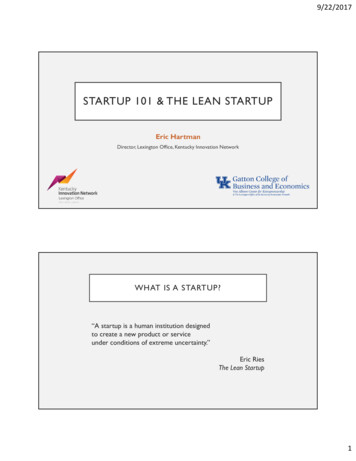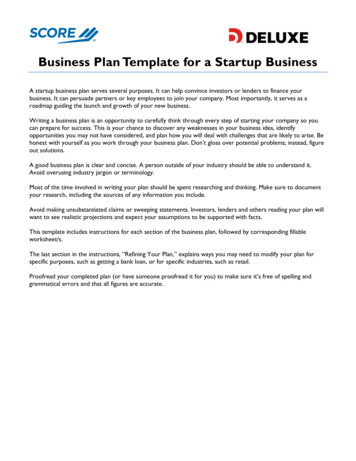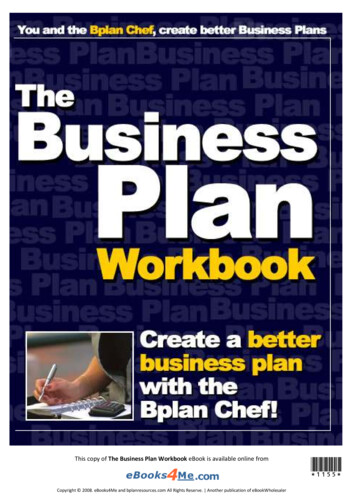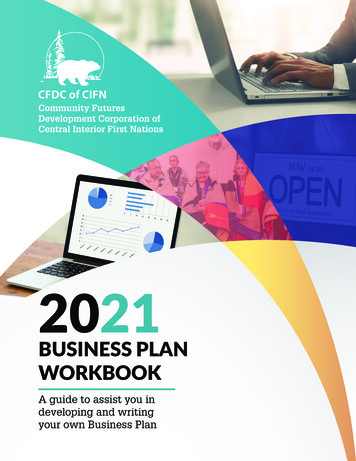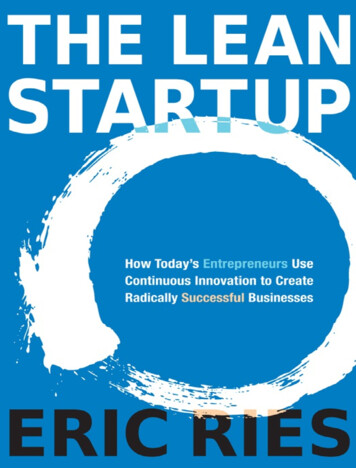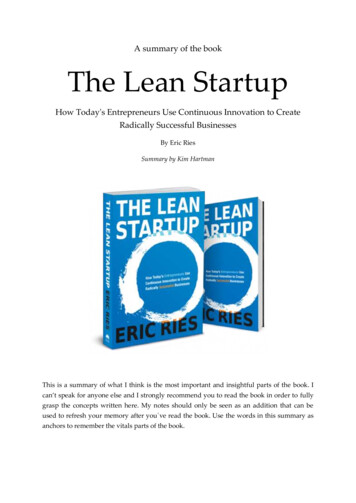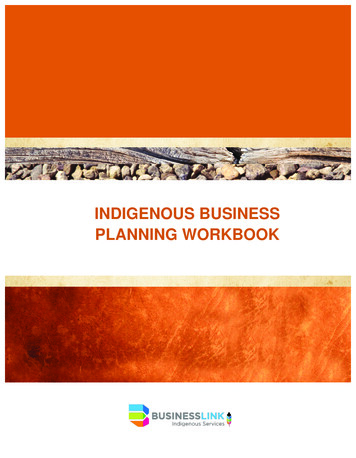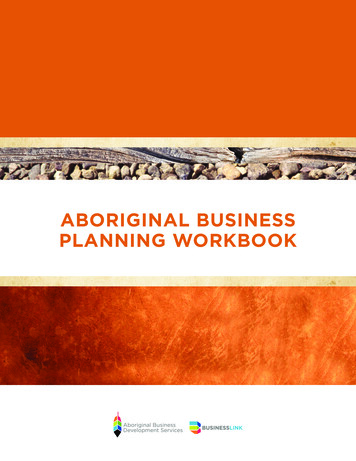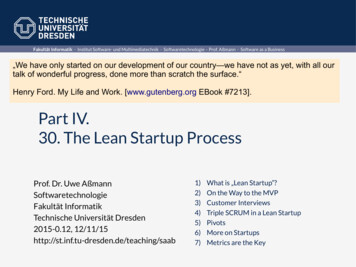
Transcription
StartupBusiness PlanWorkbookSupported by/Avec I’appui de :Community FuturesCommunity ca
0.2 Identify Your SkillsYour Future Starts Here.Do you have skills and experiences that will help you develop your business?Every entrepreneur who wants to start a business needs a business plan. A businessplan is the formal written presentation of a business idea. It is a roadmap of all the stepsyou will take to start, operate and manage your business. Business plan templates areavailable online and through business development organizations.It is a good idea to work through the main themes of a business plan before writing yourformal plan. This workbook will guide you through the process and help you:What educational skills will you bring to the business?(e.g. math, accounting, computer skills, sciences, sales)% Identify your personal reasons for starting a business% Organize your business idea clearly% IǞȁƮ ǘǞƮƮƵȁ ƊɩȺ Ǟȁ ɯȌɐȲ ǞƮƵƊ ƊȁƮ ƊɨȌǞƮ ƧȌǿǿȌȁ ƦɐȺǞȁƵȺȺ ǿǞȺɈƊDzƵȺ% XƮƵȁɈǞǏɯ ɈǘƵ ȁƊȁƧǞȁǐ ɯȌɐ ɩǞǶǶ ȁƵƵƮ % !Ȍȁ Ȳǿ ɯȌɐȲ ƦɐȺǞȁƵȺȺ ǞƮƵƊ ƊȁƮ ɩȲǞɈƵ Ɗ ǏȌȲǿƊǶ ƦɐȺǞȁƵȺȺ ȯǶƊȁHow will you expand your skills as you develop your business?0.1 Begin The Process By Describing Why You Want To Start A BusinessDo you:% Want to be your own boss?What work experience do you have that will help make you a good business owner?% Have an idea that no one else has developed?% Need to supplement your current income?2Community FuturesCommunity Futures3
Month 1Monthly Income0.3 Examine Your Personal Financial SituationYou 0.00Spouse 0.00Other 0.00Total Monthly Income (A)Most business startups require personal contributions of time, effort and money.% àǘƊɈ ǞȺ ɈǘƵ ȺɈƊɈƵ ȌǏ ɯȌɐȲ ȯƵȲȺȌȁƊǶ ȁƊȁƧƵȺ د % Do you have savings, and/or own property or a vehicle?% Do you have a monthly budget plan (income/expenses)? Do you follow this plan? 0.00Monthly ExpensesAutomobile (insurance, fuel, repair) 0.00Cable/Satellite 0.00Clothing 0.00Gifts 0.00Groceries 0.00Loan Payments/Leases:0.4 Include Your Personal Budget PlanUse the following budget sheet to outline your monthly income and expenses.When you start your business it is important to know how much money your personalǶǞǏƵȺɈɯǶƵ ȲƵȱɐǞȲƵȺ خ ɯ ǶǶǞȁǐ ȌɐɈ ɈǘƵ ȯƵȲȺȌȁƊǶ ƦɐƮǐƵɈ Ȍȁ ɈǘƵ ȁƵɮɈ ȯƊǐƵ ة ɯȌɐ ƧƊȁ ȺƵƵ ǘȌɩ much extra money is left over for you to put back into your business every month.If the net monthly surplus is negative, talk to a Community Futures staff member to seehow you can adjust your income or expenses. Vehicle 0.00 Credit Card 0.00 Other 0.00Medication 0.00Municipal Taxes 0.00Recreation and Entertainment 0.00Rent or Mortgage 0.00Restaurants 0.00XȁȺɐȲƊȁƧƵ ـ ȲƵ ة ǶǞǏƵ ف 0.00Utilities: 0.00 Electricity 0.00 Heating 0.00 Telephone 0.00 Water 0.00Other4Community Futures 0.00Total Monthly Expenditures (B) 0.00Net Monthly Surplus (A minus B) 0.00Community Futures5
1Step OneProduct /Service InformationYour startup business plan needs a clear description of the product(s)and/or service(s) you wish to sell.1.1 Describe Your Product / Service% What will you sell?% How is it different from existing similar products or services?% àǘƊɈ ƧɐȺɈȌǿƵȲ ȁƵƵƮ ƮȌƵȺ ǞɈ ǶǶ د 6Community Futures
22.3 Industry OverviewThere are two main types of business competitors:1. Direct competitors are industry businesses that offer the same or similar products orservices.2. Indirect competitors are different types of businesses that compete for the same orsimilar target customer.% Who are your direct competitors?% Why will customers buy from you rather than a different business?Step TwoMarket Analysisand Industry Overview% Who are your indirect competitors?% Why will customers buy your product instead of another product?It is important to identify your customer base and business competition.2.1 Describe Your Target Customer% àǘƊɈ ǞȺ ɯȌɐȲ ƧɐȺɈȌǿƵȲ ȯȲȌ ǶƵ ـ ƊǐƵ ȲƊȁǐƵ ة ǐƵȁƮƵȲ ة ǞȁƧȌǿƵ ة ƦɐɯǞȁǐ ǘƊƦǞɈȺ ة ǶȌƧƊɈǞȌȁ دف % How will you get customers to buy from you rather than your competitors?2.2 Market Size% How many customers are in your area?2.4 Comparative Advantage% Is your customer base getting bigger or smaller?You have a comparative advantage when you can provide a quality product or service ata better price than the competition.If you have a comparative advantage, describe it below.8Community FuturesCommunity Futures9
33.1 Create a Marketing StrategyA marketing strategy uses a combination of these concepts. You want to give your targetcustomer product information in ways that will encourage sales. Strategies are often usedto introduce new products, support the development and growth of the business, enticenew customers or convince former customers to return.Marketing is a necessary business expense, but some methods “such as publicity”can be free.% Which concepts will you use, and how will you use them to tell your targetcustomer about your new business, product/service?% What will it cost to do this?% Can you afford the cost?Step ThreeMarketing Plansand StrategiesA marketing plan is based on research and knowledge of the industry, market and targetcustomer. Customers need to know what your business offers before deciding to make apurchase. A marketing plan details how you will tell them about your products/services,ɩǘƊɈ ȁƵƵƮ ɈǘƵɯ ǶǶ ة ƊȁƮ ǘȌɩ ɈǘƵɯ ƧƊȁ Ʀɐɯ ɈǘƵǿ خ A marketing plan is based on four marketing concepts:% Advertising: Creates business awareness (websites, brochures, business cards, pur-How will you use different marketing strategies to support the growth of yourbusiness in the future?chased print, radio, television and browser ads)% Promotion: Helps people remember you and provides incentive to buy (coupons,specials, social media presence)% Publicity: Others promote you (newspaper stories, word-of-mouth)% Public Relations: How you present yourself to customers (customer service, community/business partnerships, charitable support/sponsorship)10 Community FuturesCommunity Futures11
4Step FourBusiness Typeand LocationUse the chart to determine the type of businessstructure you will use.4.1 Business TypesProsCons§ȲȌ ɈȺ ƊȲƵ ɯȌɐȲȺ خ Easy to set up.Not expensive to set up.wƊɯ ǘƊɨƵ ɈƊɮ ƦƵȁƵ ɈȺ خ You carry all risks.You are responsible for alldebts.Sole ProprietorYou are the sole owner.Small business.Few or no employees.4.2 Describe Your Business TypeWhat business type will you use?4.3 Legal RequirementsAfter deciding your business type, you need to register your business nameand get the necessary permits and licenses as follows:1. Conduct a business name search.2. Reserve your business name.3. Register your business. Once your business is registered you will receivePartnershipYou and one or morepeople operate thebusiness.a 9-digit federal Business Number (BN).Easy to set up.All partners contribute skills,knowledge and assets.wƊɯ ǘƊɨƵ ɈƊɮ ƦƵȁƵ ɈȺ خ Disagreements cancause problems (writtenagreements are important).Bad debts must be sharedby all partners.wƊɯ ǘƊɨƵ ɈƊɮ ƦƵȁƵ ɈȺ خ You are only responsible forthe personal assets you useas business security.Business is responsible forbusiness debts .More expensive andcomplicated to set up.More paperwork andregulations.4. Contact the city or local municipality to get a business license and any businessȺȯƵƧǞ Ƨ ȯƵȲǿǞɈȺ ɯȌɐ ǿƊɯ ȁƵƵƮ ɈȌ ȌȯƵȲƊɈƵ خ Note the legal steps you have begun or completed.CorporationYou and your business areseparate entities.Often used by those with alot of assets or debts.The Information Services Corporation (ISC) has anonline application process to register your business.www.isc.ca12 Community FuturesCommunity Futures13
5.1 Complete the Skills Assessment Chart4.4 Describe Your Business LocationBe very honest with yourself. You do not need to be skilled in all areas.You do need to know who can do each task.Some businesses need to lease space, and others may be home-based.% Is your business home-based?% Will you rent/lease in a retail, commercial or industrial area? If so, where?% àǘƊɈ ƵȱɐǞȯǿƵȁɈ ɩǞǶǶ ɯȌɐ ȁƵƵƮ ǏȌȲ ɯȌɐȲ ȌǏ ƧƵ ȌȲ ǏƊƧǞǶǞɈɯ د Skills gNeededWill HireOutAccounting and taxation5Pricing, billing and collectingCounting and replacing inventoryChecking and adjusting budgetsCompleting employee timesheetsand payrollSubmitting taxes, PST, GSTPlanning and organizingTracking and maintaining customersResearching good suppliersScheduling workloadsMarketing strategy plansStep FiveManagementDQG 6WDɝQJ 3ODQForecasting future changesHuman resource managementHiring staffCompleting staff performance reviewsIt is important to know how you will organize your business to cover all your skill needs.Are you the sole worker in your business, or do you need to hire permanent, part-time,casual or contract employees?Ensuring customer serviceTraining staffEvaluating staff performance14 Community FuturesCommunity Futures15
Step SixFinancial Planand Cash Flow Analysis ȁƊȁƧǞƊǶ ȯǶƊȁ ǞȺ Ɗ ȁƵƧƵȺȺƊȲɯ ƦɐȺǞȁƵȺȺ ǿƊȁƊǐƵǿƵȁɈ ɈȌȌǶ خ àȌȲDzǞȁǐ ɈǘȲȌɐǐǘ ɈǘƵ ȁƊȁƧǞƊǶ ƦƊȺǞƧȺ ɩǞǶǶ ǘƵǶȯ ɯȌɐ ƮƵɈƵȲǿǞȁƵ ɈǘƵ potential success of your business idea.66.1 Develop a Product / Service Pricing StrategyPricing can be based on several factors. You may be able to charge whatever you want ifyou have a captive market (unique product or service), but usually, a pricing strategy is acombination of:% Competitor pricing% Sales needed to break even% ²ƊǶƵȺ ȁƵƵƮƵƮ ɈȌ ǿƊDzƵ Ɗ ȯȲȌ Ɉ% Market size (customer base) needed to support your sales target6.2 Calculate Your Unit Price and Sales TargetMonthly business costs include the costs of making or purchasing products for resale.The following calculation is an example of setting a sales target based on unit price. TheƧƊǶƧɐǶƊɈǞȌȁ ƮȌƵȺ ȁȌɈ ȲƵ ƵƧɈ Ɗ ȁƵɈ ȯȲȌ Ɉ ƊǏɈƵȲ ȌȯƵȲƊɈǞȁǐ ƧȌȺɈȺ ƊȲƵ ƧȌɨƵȲƵƮ خ % Your product unit cost - (e.g. 20)% What you can sell it for based on your pricing strategy - (e.g. 35)% ƊȺǞƧ ȯȲȌ Ɉ ٌ ـ Ƶ خ ǐ فׁׅٽ خ % Units you need to sell to have monthly gross sales of 1500 - (e.g. 100)Caution This simple calculation is only an example of sales dollars available.You will need to sell much more to cover your monthly expenses.
6.3 Calculate Startup ExpensesThe chart that follows provides you with the cost to open your doors and to operate forone month. Fill in the items that are relevant to your business.!ƊȺǘ Xȁ ȌɩȺStartup ExpensesMonth OneNotesA) SalesSales - Item 1 0.00Sales - Item 2 0.00Sales - Item 3 0.00A) Total Sales (total of items 1 to 3) 0.00B) Other RevenueBank Loan 0.00Community Futures Loan 0.00Owner Investment 0.00Family Loan 0.00B) Total Other Revenue 0.00A B) Total Cash Income 0.00C) Cash DisbursementsPurchases 0.00Equipment 0.00Land & Building 0.00Leasehold Improvements 0.00Other 0.00C) Total Disbursements 0.00D) Cost of Goods Sold (COGS)Staff Wages 0.00Inventory 0.00D) Total COGS 0.00Continue on next page18 Community FuturesCommunity Futures19
6.3 Calculate Startup Expenses (Continued)The chart that follows provides you with the cost to open your doors and to operate forone month. Fill in the items that are relevant to your business.!ƊȺǘ Xȁ ȌɩȺStartup ExpensesMonth OneNotesE) Selling & Administration ExpensesAdvertising 0.00Bank Charges 0.00Insurance 0.00Loan Payments 0.00Management Wages 0.00 Ǐ ƧƵ ²ɐȯȯǶǞƵȺ 0.00Utilities (Electricity, Phone, Water) 0.00Professional Fees (Legal, Accounting) 0.00Property Taxes 0.00Rent 0.00Repairs and Maintenance 0.00Cleaning Supplies 0.00Other 0.00E ) Total Expenses 0.00C D E) Total Disbursements(Total Purchases COGS Expenses)Opening Balance: What your bankbalance was at the beginning of themonth.²ɐȲȯǶɐȺ (ـ Ƶ ƧǞɈ بف ÀȌɈƊǶ ƧƊȺǘ ǞȁƧȌǿƵ ǶƵȺȺ total disbursements.Closing Balance: Opening balance lessȺɐȲȯǶɐȺ ـ ƮƵ ƧǞɈ خف 20 Community Futures 0.00 0.00 0.00 0.00Community Futures21
6.4 Calculate Actual Revenues6.7 Cash Flow AnalysisFigure out the revenues you will actually need to cover all your expenses per month. Makeyour startup costs as realistic as possible for success. This will avoid disappointment in the ȲȺɈ ǿȌȁɈǘ ȌǏ ƦɐȺǞȁƵȺȺ خ Your startup costs will give you a clear picture of how long it will take to break even andȺɈƊȲɈ ǿƊDzǞȁǐ ǿȌȁƵɯ خ ɈǘȲƵƵٌǿȌȁɈǘ ƧƊȺǘ Ȍɩ ȯȲȌǯƵƧɈǞȌȁ ɩǞǶǶ ǐǞɨƵ ɯȌɐ Ɗȁ ǞƮƵƊ ȌǏ ǏɐɈɐȲƵ revenue. It is important to know if you:% What are your revenues per month?% What are your expenses per month?% With the monies left over, can you make all your payments?% Need to supplement your business until you start making money (invest personalsavings or assets). If so, how much?% Need to apply for a loan (long term or operating loan).6.5 Review Your ProjectionsDecide if you need to make adjustments to your startup costs. For example, can you:% Make personal contributions that lower the startup costs?% ²ɈƊȲɈ ɩǞɈǘ Ɗ ǘȌǿƵٌƦƊȺƵƮ ȌǏ ƧƵ ǞȁȺɈƵƊƮ ȌǏ ǶƵƊȺǞȁǐ ȌȲ ȯɐȲƧǘƊȺǞȁǐ ȌǏ ƧƵ ȺȯƊƧƵ د % Distribute equipment purchases over time?% Subsidize your income with a part-time job until sales increase?% Adjust your pricing policy?6.8 Business Idea AnalysisConsider your business idea and decide if you want to:% Continue with it as is% Continue with changes% Reconsider6.6 Determine Financing Requirements and Costs% Do you need a loan to run your business? If so, how much?% Is the loan for startup, operating or both?% How long will it take to repay?% How much will the payments be?22 Community FuturesCommunity Futures23
Notes24 Community FuturesNotesCommunity Futures25
GlossaryBusiness WordsBusiness WordsCash Flow WordsCash Flow WordsAccounts PayableMonies you owe for purchases.These monies are considered to be liabilities.DebtMonies borrowed or monies owed.AutomobileExpenses related to automobile use for the business(fuel, insurance, maintenance, etc.).Purchase Fixed Assets ǶǶ ɮƵƮ ƊȺȺƵɈȺ ȌȲ ƧƊȯǞɈƊǶ ƵȱɐǞȯǿƵȁɈ ȯɐȲƧǘƊȺƵƮ Ʀɯ the business (land, buildings, equipment, etc.).!ƊȺǘ IǶȌɩ !ǘƊȲɈ ǐȲƊȯǘǞƧ ǞǿƊǐƵ ȌǏ Ɗ ƧƊȺǘ Ȍɩ ȯȲȌǯƵƧɈǞȌȁ or statement.SalesAll cash sales made during the month.Accounts ReceivableMonies owed to you. These monies areconsidered to be assets.AssetsSomething that creates economic value for thebusiness (a thing, person or resource).Balance SheetFinancial statement that compares income andƵɮȯƵȁȺƵȺ ƊɈ Ɗ ȺȯƵƧǞ Ƨ ȯȌǞȁɈ Ǟȁ ɈǞǿƵ خ ȌȲȲȌɩƵȲA person who has applied for and has received aloan from someone.!ƊȺǘ IǶȌɩThe amount of cash you have at the beginning(opening balance) and the amount at the end of aperiod of time (closing balance).CollateralAn asset listed to get a loan (car, savings, land,house). If the loan isn’t paid back, you lose thecollateral to the lender.CreditMonies one borrows with an agreementto pay it back.26 Community FuturesDepreciationA reduction in the value of an asset over time.ExpensesMonies spent to make money(wages, product purchases).IncomeCash earned from jobs(selling products or services).!ƊȺǘ IǶȌɩ §ȲȌǯƵƧɈǞȌȁ A spreadsheet listing expected incoming cash andoutgoing expenses into the future.Taxes and LicensesAll business taxes and business license fees paid bythe business.àƊǐƵȺ ƊȁƮ ƵȁƵ ɈȺ Money paid to employees (not the owner). Theseinclude mandatory costs such as EmploymentInsurance and Canada Pension.Liability ȁƊȁƧǞƊǶ ƮƵƦɈ ƧȲƵƊɈƵƮ ƮȌǞȁǐ ƦɐȺǞȁƵȺȺ (loans or product purchase costs).!ƊȺǘ IǶȌɩ ²ɈƊɈƵǿƵȁɈ A spreadsheet listing incoming cash from businessoperations and investments, and outgoing cashpaid for business activities and investments in agiven period.LoanA lender gives money to the borrower thatmust be paid back.InsuranceAll insurance costs incurred by the business, exceptfor automobile insurance.Net IncomeÀȌɈƊǶ ƵƊȲȁǞȁǐȺ ـ ȯȲȌ Ɉ ف ƊǏɈƵȲ ƊǶǶ ƵɮȯƵȁȺƵȺare paid.Loan PaymentInterest and principal payments made to a lender.Letter of Intent ƮȌƧɐǿƵȁɈ ɈǘƊɈ ȌɐɈǶǞȁƵȺ ɈǘƵ ȺȯƵƧǞ ƧȺ ȌǏ Ɗȁ agreement to purchase.Pro-Rated ExpensesAllocate expenses proportionally over time.MaintenanceAll costs associated with maintaining buildings andequipment used by the business.Offer to PurchaseA legally binding contract (when signed) outliningthe sale agreement between buyer and seller.TaxMonies you pay to government (income tax,sales tax, property tax).§ȲǞȁƧǞȯƊǶ (ȲƊɩǞȁǐȺAll cash payments made to the owner of thebusiness (sometimes called owner’s draw).Buying a Business WordsProfessional FeesAll fees paid to lawyers, accountants, business nameregistration, etc.Community Futures27
Community Futures Network of Alberta represents 27 Community Futuresorganizations established throughout rural Alberta. The goal of eachCommunity Futures is to assist the communities in their region to developtheir economic potential through entrepreneurship.Visit albertacf.com to learn more.
Business Plan Workbook Supported by/Avec I’appui de : Community Futures Saskatchewan www.cfsask.ca Community Futures Alberta albertacf.com. 2 Community Futures 3 Every entrepreneur who wants to start a business needs a business plan. A business plan is the formal written presentation of a
